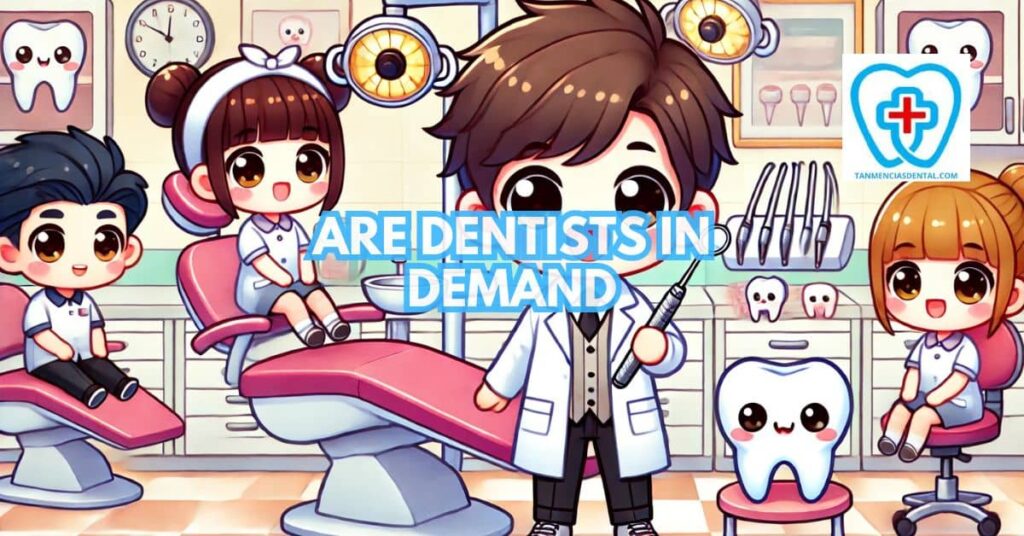Are dentists in demand?
This question is increasingly important as healthcare systems evolve and more people recognize the link between dental health and overall well-being.
Factors like an aging population, greater access to healthcare, and new technology in dentistry are shaping the future of the profession.
These changes not only affect how dentists work but also how many will be needed in the years ahead.
We’ll explore the trends driving the demand for dentists and what this means for the future of dental careers.
1. Is Dentistry a High-Demand Career?
Dentistry continues to be a high-demand career due to its essential role in maintaining public health and its specialized requirements.
The consistent requirement for dental care across diverse age groups ensures a steady need for skilled dental professionals.
Dental schools are reporting strong application numbers, reflecting sustained interest in the field and indicating robust future projected growth.
This enduring interest is partly due to the comprehensive dental education that equips new dentists with a wide range of skills and knowledge.
Despite economic fluctuations, dentistry maintains its appeal, underscored by its resilience during economic downturns, which stabilizes its demand.
Dentists typically experience high job security and professional satisfaction, contributing to the career’s attractiveness.
These factors collectively affirm that dentistry is not only a high-demand profession but also one that offers a rewarding and stable career path.
🦷 Saturday Smiles: Your Ultimate Guide to Scheduling Dental Appointments!
2. Rising Demand Due to the Aging Population
The aging population is a major factor driving the need for more dentists, as older adults face unique oral health challenges.
Issues like gum disease, tooth decay, and tooth loss are far more common among elderly patients, often requiring specialized care and regular dental visits.
Additionally, with people living longer and retaining their natural teeth well into old age, the demand for routine maintenance and advanced treatments has grown.
Geriatric dentistry, which focuses on the oral health needs of seniors, is becoming a crucial area of specialization.
This trend not only highlights the importance of dental care for older adults but also creates opportunities for dentists to expand their skills.
Moreover, the profession offers strong work-life balance, making it an appealing choice for those seeking a fulfilling and flexible career.
As the population continues to age, dentists will play a vital role in ensuring the long-term oral health of their communities.
🦷 Soap vs. Toothpaste: The Shocking Truth About Brushing Your Teeth with Soap!
3. Dentist Job Growth: Replacing Retiring Dentists
The retirement of a large cohort of practicing dentists is creating a significant gap in the dental workforce.
This generational change is prompting a wave of job openings for newly trained dentists.
The cycle of retirement and hiring contributes to the overall health of the profession by bringing in fresh talent and new techniques.
Ensuring a smooth transition in the workforce is critical for maintaining the quality of dental care.
Programs aimed at early-career dentists are essential to preparing them to take over established practices successfully.
🦷 Soda or Sparkle: Are Carbonated Drinks Sabotaging Your Smile?
4. Public Health Focus: Increased Awareness Fuels Demand for Dental Services
There has been a noticeable increase in public health initiatives focused on dental health, which has raised awareness among the general population.
These campaigns educate people on the importance of regular dental checkups and the prevention of oral diseases, thereby increasing the demand for dental services.
Schools and community centers are often collaborators in these public health efforts, which helps reach a broader audience.
Such initiatives not only promote better oral hygiene but also normalize regular visits to the dentist.
As public awareness grows, dental practices see a more consistent flow of patients, enhancing the need for more dental professionals.
🦷 Unlock Your Brightest Smile: Essential Steps for Effective Oral Prophylaxis!

5. Meeting Needs in Underserved Areas: Addressing Geographic Disparities
Many regions, particularly rural and economically disadvantaged areas, suffer from a lack of adequate dental care services.
Governments and non-profit organizations are increasingly focused on addressing these disparities by providing incentives for dentists to practice in underserved areas.
These incentives can include student loan forgiveness, grants, and higher pay.
The aim is to ensure that all populations have equal access to dental care, regardless of their geographic location.
Such efforts are gradually reducing the gap in dental health services between urban and rural areas.
🦷 Braces and Teeth: Can Your Pearly Whites Really Fall Out? Debunking the Myths!
6. Technology in Dentistry: How Advancements Impact Demand
Advancements in dental technology, such as 3D imaging, teledentistry, and computer-aided design and manufacturing (CAD/CAM), are transforming the field.
These technologies not only enhance the precision and efficiency of dental treatments but also improve patient outcomes.
They attract more patients to seek out advanced treatments that were not available or affordable before.
Also, the integration of new technologies requires dentists to continually update their skills, which can lead to a higher demand for continuing education and specialized training.
This technological shift is making dental care more accessible and appealing, thus expanding the market for dental services.
🦷 Freshen Up Anywhere: Mastering the Art of Brushing Your Teeth Without Water!
7. Dental Insurance and Demand: Exploring the Potential Correlation
The availability of dental insurance significantly influences an individual’s likelihood of seeking regular dental care.
In regions where dental insurance is more prevalent, such as in many developed countries, there is a higher demand for routine and preventative dental services.
Insurance coverage reduces the financial barrier for patients, leading to increased utilization of dental services.
However, in areas where dental insurance is less common, out-of-pocket costs can deter people from seeking necessary dental care, negatively impacting overall demand.
Policy changes that increase the coverage of dental insurance could potentially drive a higher demand for dental services.
🦷 Tartar Trouble? Discover the Best Mouthwash for a Healthier Smile!
8. Job Growth in Dental Specialties: Orthodontists, Oral Surgeons and Others
Specialized dental fields such as orthodontics, oral surgery, and pediatric dentistry are experiencing significant growth.
The availability of new treatment options and a growing awareness of the significance of particular dental health issues are driving factors in the demand for these specialists.
Orthodontists, for example, are seeing an increase in patients of all ages seeking alignment treatments, partly due to newer, less visible technologies.
Oral surgeons are essential for complex procedures that general dentists may not perform, such as impacted wisdom tooth extractions and reconstructive surgery.
The expansion of these specialties is enhancing the overall scope and capability of dental care services.
🦷 Teeth Cleaning in Marikina: Your Path to a Healthy and Radiant Smile!
9. Teledentistry’s Influence: The Future of Dental Service Delivery
Teledentistry is revolutionizing dental care by making it more accessible, especially in remote areas where traditional dental visits are challenging.
This technology allows dentists to diagnose and provide follow-up care virtually, reducing the need for physical office visits.
It is particularly beneficial during times when face-to-face interactions are limited, such as during public health emergencies.
The convenience and efficiency of teledentistry are likely to make it a permanent fixture in the future of dental care.
As more dental practices adopt this technology, the demand for services that can be provided remotely is expected to increase.
🦷 The Unsung Heroes: How Associates Enhance Comprehensive Dental Care Today!
10. Economic Considerations: Dental Care Demand Amidst Fluctuations
The demand for dental care can vary with economic conditions, as it often depends on individuals’ disposable income and the prioritization of healthcare.
During economic downturns, some may defer non-essential dental procedures due to cost concerns.
However, essential dental services tend to remain stable, as they are necessary for maintaining overall health.
Government programs and private insurance can buffer the impact of economic fluctuations by providing financial support for dental care.
Dentists need to be aware of these economic patterns, as they can affect both the demand for services and the financial health of their practices.
🦷 Gingivitis Uncovered: Can Neglecting Your Gums Really Be Life-Threatening?
11. Dentist Jobs: Salary, Work Environment, and Cost-of-Living Variations
The compensation for dentists can vary widely depending on geographic location, the cost of living, and the dentist’s specialty.
Urban areas typically offer higher salaries due to a greater demand for dental services, but they also often have higher costs of living.
Work environments in dentistry can range from private practices to hospitals and community clinics, each offering different types of benefits and challenges.
Flexibility in work hours and conditions is a significant draw for the profession, allowing dentists to balance personal and professional life effectively.
These variations can significantly impact job satisfaction and lifestyle for dental professionals.
🦷 Gum Infections: What You Need to Know About the Risks and Consequences!
12. Caring for Dentists’ Mental Health
Dentists often work long hours and face high levels of stress, which can lead to burnout.
This stress can make it hard for them to perform well at work and enjoy their personal lives.
Support systems like counseling, peer groups, and wellness programs are important for helping dentists stay healthy.
Many dental offices are creating healthier work environments by offering these mental health resources.
In addition, dentists are adopting strategies like flexible schedules and part-time work to better balance their jobs and personal time.
🦷 Dental Clinic in Marikina City
👨⚕️ Conclusion
Technology advancements, demographic changes, and a greater emphasis on dental health within the context of public health are all driving the field of dentistry’s positive growth trajectory.
Despite economic fluctuations, the fundamental need for dental care ensures a steady demand for dental professionals.
The increasing integration of dental specialties and innovations like teledentistry are set to further expand the scope and reach of dental services.
For those considering a career in dentistry, the outlook is promising, offering opportunities for a fulfilling professional life that makes a significant impact on community health.
The future of dentistry continues to look bright as it adapts to new challenges and opportunities.
😊 Self-Promotion
Visit Tan-Mencias Dental Clinic in Parang, Marikina City, where your smile is our top priority!
Our skilled team is ready to provide you with the highest quality dental care in a comfortable and welcoming environment.
Have questions or need to discuss your dental health?
Feel free to call us at 9171451074, send a message through our Facebook page, or contact us via our website’s contact page.
We look forward to helping you achieve and maintain a beautiful smile—reach out to us today and let us take care of your dental needs!

